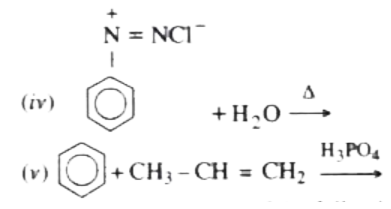Complete the following reaction :
(CH3CH2COO)2Caheat−−→
To complete the reaction of calcium propanoate upon heating, we can follow these steps:
1. Identify the Reactant:
The reactant is calcium propanoate, which can be represented as (CH3CH2COO)2Ca. This indicates that there are two propanoate groups attached to a calcium ion.
2. Structure of Calcium Propanoate:
The structure can be depicted as:
Ca2+ with 2 propanoate ions: O-C(=O)-CH2CH3
This means we have two propanoate groups bonded to calcium.
3. Heating the Reactant:
When calcium propanoate is heated, it undergoes thermal decomposition. The reaction involves the breakdown of the propanoate groups.
4. Formation of Products:
Upon heating, calcium propanoate decomposes to form:
- 3-pentanone (a ketone)
- Calcium carbonate (CaCO3)
The balanced reaction can be represented as:
(CH3CH2COO)2Caheat−−→3-pentanone+CaCO3
5. Final Products:
The products of the reaction are:
- Main Product: 3-pentanone
- By-product: Calcium carbonate (CaCO3)
Summary of the Reaction:
The complete reaction can be summarized as:
(C3H5O2)2Caheat−−→3-pentanone+CaCO3
The reactant is calcium propanoate, which can be represented as (CH3CH2COO)2Ca. This indicates that there are two propanoate groups attached to a calcium ion.
The structure can be depicted as:
Ca2+ with 2 propanoate ions: O-C(=O)-CH2CH3
This means we have two propanoate groups bonded to calcium.
When calcium propanoate is heated, it undergoes thermal decomposition. The reaction involves the breakdown of the propanoate groups.
Upon heating, calcium propanoate decomposes to form:
- 3-pentanone (a ketone)
- Calcium carbonate (CaCO3)
(CH3CH2COO)2Caheat−−→3-pentanone+CaCO3
The products of the reaction are:
- Main Product: 3-pentanone
- By-product: Calcium carbonate (CaCO3)
The complete reaction can be summarized as:
(C3H5O2)2Caheat−−→3-pentanone+CaCO3
Topper's Solved these Questions
- ALDEHYDES, KETONES AND CARBOXYLIC ACIDSBOOK - ICSECHAPTER - ALDEHYDES, KETONES AND CARBOXYLIC ACIDSEXERCISE - ISC EXAMINATION QUESTIONS (PART-II DESCRIPTIVE QUESTIONS) (CARBOXYLIC ACIDS)
99 Videos
- ALCOHOLS, PHENOLS AND ETHERS BOOK - ICSECHAPTER - ALCOHOLS, PHENOLS AND ETHERS EXERCISE - ISC EXAMINATION QUESTIONS
25 Videos
- APPENDIX II ( TYPICAL CONVERSIONS)BOOK - ICSECHAPTER - APPENDIX II ( TYPICAL CONVERSIONS)EXERCISE - AROMATIC CONVERSIONS
98 Videos
Similar Questions
Complete the following reaction :
CH3CH2CHOOH−−−→
View SolutionComplete the following reactions : CH3OCH3+PCl5→
View SolutionComplete the following reactions
(i) CH3−CH2−CH2−CH2−CHONi/H2−−−→A
View SolutionComplete the following reaction :
C6H5COCl+(CH3)2Cdto
View SolutionWhat is the major product obtained from the following reactions ?
CH3COCH2COOHheat−−→ product
View SolutionComplete the following reaction:
CH3CH2COOHP,Br2−−−→[A](i)alc.KOH(excess)−−−−−−−−−−−−−→(ii)H+[B]
View SolutionComplete the following reaction:
CH3CH2COOHP,Br2−−−→[A](i)alc.KOH(excess)−−−−−−−−−−−−−→(ii)H+[B]
View SolutionComplete the following reaction:
CH3CH2COOHP,Br2−−−→[A](i)alc.KOH(excess)−−−−−−−−−−−−−→(ii)H+[B]
View SolutionWrite the structure of the major organic product in each of the following reactions:
a. CH3CH2CH2Cl+NalAccetoneHeat
b. (CH3)3CBr+KOHEthanolHeat
c. CH3CH(Br)CH2CH3+NaOHWater−−−→
<br>d.CH_(3)CH_(2)CH = CH_(2) + HBr overset("Peroxide")
View SolutionComplete the following reactions :
(i) (CH3)2COLiAlH4−−−→
(ii)
(iii) CH3CH∣OH−CH3+PCl5→ (iv)

View Solution
